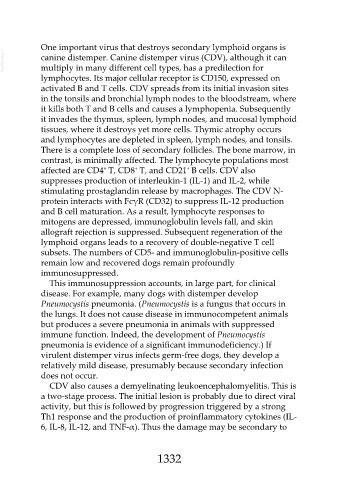Page 1332 - Veterinary Immunology, 10th Edition
P. 1332
One important virus that destroys secondary lymphoid organs is
VetBooks.ir canine distemper. Canine distemper virus (CDV), although it can
multiply in many different cell types, has a predilection for
lymphocytes. Its major cellular receptor is CD150, expressed on
activated B and T cells. CDV spreads from its initial invasion sites
in the tonsils and bronchial lymph nodes to the bloodstream, where
it kills both T and B cells and causes a lymphopenia. Subsequently
it invades the thymus, spleen, lymph nodes, and mucosal lymphoid
tissues, where it destroys yet more cells. Thymic atrophy occurs
and lymphocytes are depleted in spleen, lymph nodes, and tonsils.
There is a complete loss of secondary follicles. The bone marrow, in
contrast, is minimally affected. The lymphocyte populations most
+
+
+
affected are CD4 T, CD8 T, and CD21 B cells. CDV also
suppresses production of interleukin-1 (IL-1) and IL-2, while
stimulating prostaglandin release by macrophages. The CDV N-
protein interacts with FcγR (CD32) to suppress IL-12 production
and B cell maturation. As a result, lymphocyte responses to
mitogens are depressed, immunoglobulin levels fall, and skin
allograft rejection is suppressed. Subsequent regeneration of the
lymphoid organs leads to a recovery of double-negative T cell
subsets. The numbers of CD5- and immunoglobulin-positive cells
remain low and recovered dogs remain profoundly
immunosuppressed.
This immunosuppression accounts, in large part, for clinical
disease. For example, many dogs with distemper develop
Pneumocystis pneumonia. (Pneumocystis is a fungus that occurs in
the lungs. It does not cause disease in immunocompetent animals
but produces a severe pneumonia in animals with suppressed
immune function. Indeed, the development of Pneumocystis
pneumonia is evidence of a significant immunodeficiency.) If
virulent distemper virus infects germ-free dogs, they develop a
relatively mild disease, presumably because secondary infection
does not occur.
CDV also causes a demyelinating leukoencephalomyelitis. This is
a two-stage process. The initial lesion is probably due to direct viral
activity, but this is followed by progression triggered by a strong
Th1 response and the production of proinflammatory cytokines (IL-
6, IL-8, IL-12, and TNF-α). Thus the damage may be secondary to
1332

